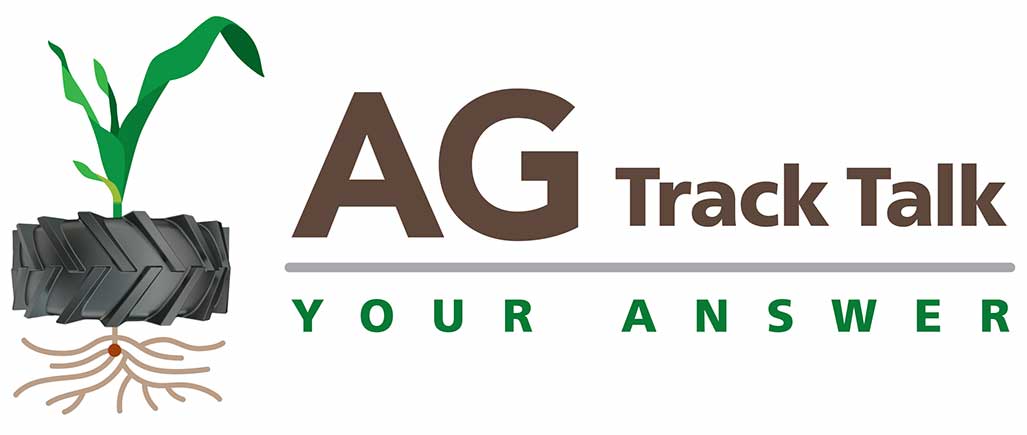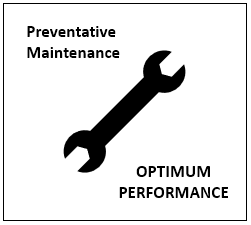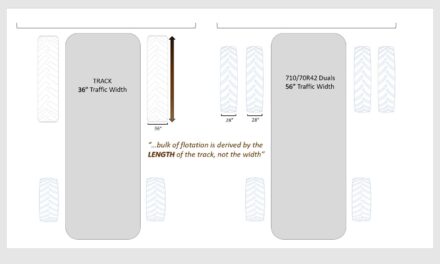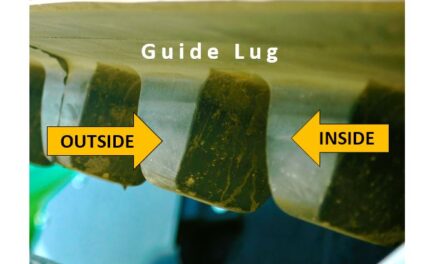QUESTION
What pre-season preventative maintenance & off season storage steps should grower take with AG Track & Undercarriage to reduce downtime and improve performance?
Soucy Track
Eric Halstead, Eng: Rubber Tracks Technical Expert / Agricultural Products
OFF SEASON
When the crops are done, it is time to prepare the farm equipment for off-season.
For tracks, there are two possible scenarios:
1) Tracks are LEFT ON the Tractor/Implement or
2) Tracks are REMOVED from the vehicle.
If tracks are LEFT ON the equipment, it is important to follow these few rules:
a) If possible, keep the tractor inside, to limit the UV and ozone effect on the rubber. Static rubber tracks will be more likely to be attacked and oxidized than tracks in movement. When stored, some areas of the rubber are in permanent tension and oxidation of these areas will create micro-cracking, reducing the life of the track.
b) If the vehicle is parked outside for a long period, cover the tracks with a tarp.
c) A silicon-free rubber protector, like Opti-bond, can be applied on the track to protect and slow down the oxidation process.
In addition to the above, if tracks are REMOVED from the vehicle:
a) Place the track on its side, on wood pallet if possible
b) Avoid sharp bending radius (keep the track as round as possible)
c) Do not stack more than two tracks high.
d) Rubber tracks are not affected by cold, so leaving tracks outside during freezing season is acceptable. However, for older tracks with some level of cracking, constant humidity could accelerate the corrosion of any steel reinforcement that could have been exposed in the cracks. Dry storage is therefore safer.
PRE-SEASON things to do:
Before leaving the garage prior to season, it is important to follow the below procedure:
a) Inspect the track thoroughly to detect major damages, like deep cuts or visible broken steel cable. Tracks may survive for a while with such damage, but the risk of downtime is increased. Refer to manufacturer’s defect document to see if the damages could be associated to a warrantable defect. Replace the track if necessary.
b) Apply a generous amount of dry lubricant on the drive lugs of the tracks. It could be talc powder, graphite powder or fine sand. It is important to protect the side surface of the drive lugs for the first few miles on the road before getting to the field.
c) Drive the vehicle for 10 minutes at high speed and verify the temperature of the side surfaces of the drive lugs to insure that the tracking of the undercarriage is correct. If a difference of more than 20°C is measured between the inner and outer side of the drive lugs, the tracking of the vehicle needs to be corrected. Follow vehicle manufacturer’s procedures for track system tracking.
Following these recommendation should allow rubber tracks to perform many years, and avoid costly vehicle down-time.
Continental
Rob Schultz: Marketing Communications Americas
ON MACHINE (Short Term Storage)
AVOID storing tracked machines in direct sunlight.
- Store indoors or cover tracks with opaque tarp.
AVOID storing tracked machines in standing water.
- Store indoors or cover tracks with waterproof tarp.
AVOID storing in one position.
- Move machines resting on their tracks once per month.
OFF MACHINE (Long Term Storage)
STORE
In “DARK” area, away from direct sunlight.
- Indoors, or cover with opaque tarp.
In “COOL” (40°F to 60°F, 4.4°C to 15.5°C) area.
- 85°F (29.4°C) or cooler for extended periods.
In “RELAXED” physical configurations.
- On edge, with bend radii greater than 30 inches with no back-bending.
In “DRAFT FREE” & “DRY” area.
- Indoors or under tarpaulin to minimize dust.
Below are general exclusions and recommendations associated with all rubber track & tire products.
Do not store tracks in closed areas with electric devices that generate ozone (such as motors), in closed areas with petrol chemicals or petrol chemical vapors.
Lastly, do not paint tracks in an attempt to protect them from ozone, moisture or other elements, and always keep fire extinguishers or halon fire suppression systems in rubber track storage areas
PRE-CONDITION (Reduce Down Time)
It is important to note that all AG Rubber Tracks must be pre-conditioned before first use of the season to reduce downtime.
LUBRICATE
In order to reduce scuffing, tracks need lubricating.
- Remove Dirt & Debris
- Spread layer of lubricating material over entire undercarriage wheels and inside of track.
- Operate for 15 min in field with loose soil
- Inspect Tracks
As for lubricating materials, we recommend the following:
- Talc Powder
- Graphite
The key is that lubricant must be non-caustic particulate material.
ROTATE
Rotate tracks from side to side in applications where uneven lateral wear is seen (and where the undercarriage adjustments necessary to correct these wear patterns do not exist).
MAINTENANCE (In Season Use)
Inspect and service the undercarriage components frequently to ensure that there is no obvious damage, that the track is being tensioned properly, and that the track exhibits no unusual wear patterns that would indicate improper camber or alignment.
- Condition track prior to EACH initial usage.
- AVOID
- Excess high-speed / sharp turns.
- Foreign objects
All information is provided in this blog solely to provoke thought. All deductions made from information on this site must be confirmed by Certified Ag Track Dealer before use. Ag Track Talk does not recommend anyone conduct track service work with exception of Certified Ag Track Dealer Professionals.



